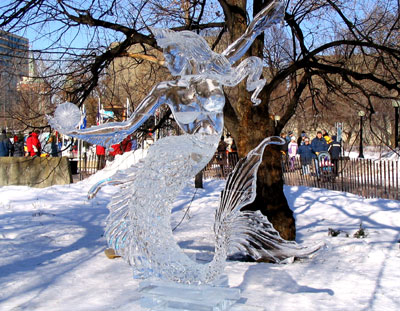After my visit to the Museum of Nature an adventure of an altogether different nature was awaiting me: the outdoor splendour of Gatineau Park, a large protected nature area measuring 361 square kilometres whose southern tip is located literally 15 minutes north of Ottawa‘s downtown area. The park itself is managed by the National Capital Commission, an organization with a mandate and mission to build the Capital region into a source of pride and unity for Canadians.
To get a better overview of this facility I met Michel Dallaire, Gatineau Park’s Manager of Recreational Services who awaited me in the lobby of the Visitor Information Centre, right next to a big 3-dimensional topographical display of the Park.
Michel explained that Gatineau Park’s most dominating topographical feature is the Eardley Escarpment which is actually a former shoreline of the Champlain Sea. The Park is a very popular destination: over the last 25 years visitor numbers went from about 700,000 day visits a year to more than 1,7 million currently. The National Capital Region surrounding Ottawa is one of the fastest-growing areas in the country and within the next 10 years about 2 million day visitors are expected in Gatineau Park, and as a result the administration’s focus has changed from development to conservation.

Michel explains the topography of the park to me
Gatineau Park offers a great variety of outdoor recreational opportunities: in the summer months it offers camping opportunities on 3 different campgrounds, more than 200 km of trails in the winter (including cross-country and snow-shoeing trails) and 165 km of trails in the summer which are multi-use and multi-seasonal. The parkways, scenic roads in a natural setting, shut down every Sunday from late May until Labour Day for bikers, roller-bladers and stroller-pushing parents to enjoy the paved trails throughout the rolling hills of Gatineau. There is even a downhill ski centre in Gatineau Park which is called Camp Fortune. Michel explained that in the 1920s and 1930s the Ottawa Ski Club started to develop a cross-country trail network and later added a down-hill ski area. Ottawa’s citizens used to come here by train to take advantage of the winter adventures that Gatineau Park has to offer.
This park fulfills a key role as a primary outdoor recreation area for Ottawa’s citizens and as a nature reserve for the entire capital region. Michel explained that there have been 3 master plans over the years for the park, and he has participated in them all since he has more than 25 years of work experience with Gatineau Park. The focus has shifted from developing the park to protecting its greenspaces and focussing on its diverse eco-systems. The key question has become how to manage the large number of visitors and provide a great recreational experience while preserving this precious natural resource for future generations of Canadians.

One of the historic displays inside the Visitors Centre
Four plans make up the current strategy for Gatineau Park: the Conservation Plan addresses the protection of habitats and green spaces while the Recreation Plan is favouring slightly different styles of recreation, emphasizing more ecologically sustainable activities. Motorized activities in the park will disappear over time and activities such as rock climbing will face tighter restrictions. The park managers collaborate closely with representatives from different outdoor clubs and associations to ensure excellent buy-in and collaboration. The Heritage Plan focuses on the architectural and historic heritage of the park which includes, for example, former Prime Minister William Lyon Mackenzie King’s residence as well as other historical buildings. Last but not least, the Green Plan endeavours to tie in the park into a more overall ecologically sound master plan by evaluating ways of connecting public transit to the park as at this moment 95% of people come to the park by car. Park management strives to make the entire Gatineau Park experience more environmentally sustainable.
Michel next enlightened me on the types of trail systems available in the park: in total more than 165 km of trails are availabe during the summer throughout the park. Recreational pathways (about 15 km) are paved and accessible to users of bicycles, in-line skates and strollers. About 90 km of shared use trails are built of mulch, gravel or hardened clay and are used by mountain-bikers and hikers, and hiking trails are for pedestrian use only. 30 km of parkways are closed to road traffic regularly to give non-motorized wheeled athletes a chance to enjoy themselves without road traffic and exhaust fumes. It takes about 20 minutes by bike from Parliament Hill to the southernmost entrance of Gatineau Park, an example of how accessible the park is to all the urban residents of Ottawa and its surroundings. Every Sunday from late May to Labour Day, more than 30km of park roads are blocked off to vehicular traffic for the Alcatel Sunday Bikedays and made accessible to bikers and inline skaters.
 |
|
A pond, created by a beaver dam




